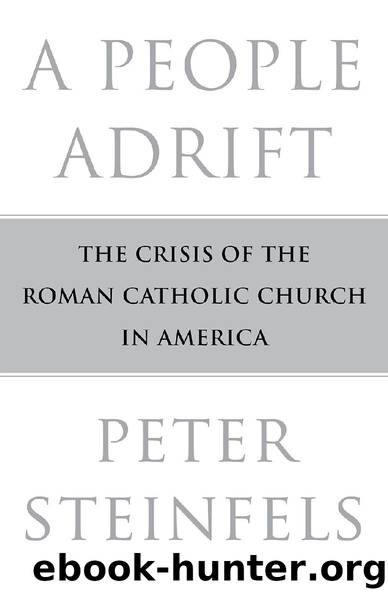A People Adrift by Peter Steinfels

Author:Peter Steinfels
Language: eng
Format: epub
Publisher: Simon & Schuster
So while the NCEA assessments are impressive diagnostic tools for the DREs and catechists in individual parishes, a true picture of the effectiveness of all catechetical programs nationwide, or even diocese-wide, remains uncharted. So do comparisons between different types of programs, those primarily employing traditional classroom styles of instruction, those engaging parents and focusing on catechesis in the home, those preferring retreats or summer sessions to weekly hour-long sessions, and so on.
One thing that the NCEA assessment instrument indubitably reveals has nothing to do with students but everything to do with the people who have constructed it. It shows what leaders of the catechetical establishment consider important to measure, and that turns out to be far from the caricature that some critics have presented.
Yes, there is a catechetical establishment, just as there is a liturgical establishment. There are leading graduate programs and institutes, senior scholars and popular gurus, respected credentials, professional organizations, newsletters, conferences, scholarly journals, how-to magazines, and so on. The catechetical establishment is liberal, loyal to a liberal view of Vatican II, and like the liturgists, has had to withstand a good many suspicions and denunciations. Over the years, critics have complained vociferously about textbooks, curriculums, and teaching materials. These are said to be watering down the faith or even propagating insidious heresies. The catechetical movement itself has been portrayed as a cabal skirting and subverting the authority of the bishops and the papacy, replacing true faith with politically liberal and radical secularism. Here and there, such hyperbolic criticism may have been justified—religious education could not have undergone such a major reorientation without throwing up some really bad ideas. Occasionally, the attacks have provoked useful rethinking, but just as often, I suspect, they have only reinforced defensiveness, overshadowed and discredited more nuanced criticism, and slowed rather than spurred the necessary correctives to postconciliar floundering.
Currently, such undiscriminating onslaughts seem particularly wrongheaded. Over the years, the textbook series and associated materials, either identical or similar to those used in Catholic schools, have been substantially revised and their content fortified. Half the dioceses spell out what books and materials can be used; even more give parish programs specific guidelines for their curriculum. The latest version of the NCEA assessments specifies over two hundred “fundamental terms in the Catholic vocabulary”—from “act of contrition,” “Advent,” and “annulment” to “Vatican II,” “vocation,” and “Yahweh”—that students should know as they progress from level to level. If children and young people absorbed and retained the key concepts, biblical themes, liturgical and sacramental symbols and actions, moral principles, major events and figures in church history, and personal spiritual practices outlined here, they would have as complete a grasp of their Catholic heritage as any generation has and certainly a better balanced one than the generations raised on the Baltimore Catechism. Catechetical directors and pastors rank their programs more effective in conveying knowledge of the Catholic faith and scripture than in fostering the spiritual and moral habits of the young or connecting them to the parish’s worship and service or to the larger church.
Download
This site does not store any files on its server. We only index and link to content provided by other sites. Please contact the content providers to delete copyright contents if any and email us, we'll remove relevant links or contents immediately.
Joan of Arc by Mary Gordon(3251)
Victory over the Darkness by Neil T. Anderson(2382)
The Gnostic Gospels by Pagels Elaine(2021)
Devil, The by Almond Philip C(1895)
The Nativity by Geza Vermes(1845)
The Psychedelic Gospels: The Secret History of Hallucinogens in Christianity by Jerry B. Brown(1822)
Going Clear by Lawrence Wright(1566)
Going Clear: Scientology, Hollywood, and the Prison of Belief by Lawrence Wright(1566)
Barking to the Choir by Gregory Boyle(1503)
A TIME TO KEEP SILENCE by Patrick Leigh Fermor(1494)
Old Testament History by John H. Sailhamer(1493)
Augustine: Conversions to Confessions by Robin Lane Fox(1469)
A History of the Franks by Gregory of Tours(1394)
The Knights Templar by Sean Martin(1386)
The Bible Doesn't Say That by Dr. Joel M. Hoffman(1371)
A Prophet with Honor by William C. Martin(1369)
by Christianity & Islam(1344)
The Amish by Steven M. Nolt(1250)
The Time Traveler's Guide to Medieval England by Ian Mortimer(1209)
